Face-Off: Uncharted 3: Drake's Deception on PS4
Digital Foundry concludes its analysis of the Nathan Drake Collection and looks at day one patch improvements.
As a culmination of Naughty Dog's work over the course of the PlayStation 3 generation, Uncharted 3: Drake's Deception delivers a level of visual quality few games on the platform could hope to match. First released in 2011, Uncharted 3 remains the most divisive of Naughty Dog's PlayStation 3 games. In the wake of the spectacular Among Thieves, the hype surrounding the release of Drake's Deception was immense and in the eyes of certain fans, the game didn't entirely live up to those expectations. Yet, given a second chance, there's an adeptly-crafted game here, something that becomes clear when revisiting the title in 2015. When separated from the hype, Uncharted 3 really shines - especially on PlayStation 4.
While the game itself may have fallen short of initial expectations in some quarters, its technological foundations certainly do not. Uncharted 3 stands as one of the most visually ambitious titles to have graced Sony's last-generation console. Pushing effects work, animation and scene complexity through the roof, it is, quite simply, a beautiful game. While it lacks the larger levels and impressive indirect lighting of The Last of Us, it offers a spectacle that still manages to eclipse many games released today, backed up by characterisation and story-telling Naughty Dog's rivals are still struggling to match.
With such an incredible foundation, just what could we expect from a remaster then? Looking back at the first two Uncharted games, Bluepoint remade a tremendous number of assets to enhance each title but with Uncharted 3, that's not really the case. Asset quality remains very similar to the original game throughout the experience. However, if you look closer, Bluepoint's attention to detail still manages to shine through in this excellent remaster.
The most important change is actually apparent right out of the gate - a reduction in input latency. When Uncharted 3 first launched, users complained of sluggish aiming in comparison to its prequels. Of the three games, Uncharted 3 suffers from the highest input latency by quite a wide margin. In response to these complaints, Naughty Dog attempted to rectify the situation by implementing an alternate aiming mode in the first patch. Yet, even with this change in place, the game just didn't feel quite right.
In the move to PlayStation 4, Bluepoint is given the opportunity to finally put this issue to rest - and we feel it has succeeded: Drake's Deception now offers quick, responsive controls that are a pleasure to use. It's easier than ever to pull off accurate shots and there is never a sense that camera movement is weighed down by unwanted latency. Quite frankly, no game in this collection needed this tweak more than Uncharted 3, and the results here are excellent.
This is coupled with the obligatory boost to frame-rate which, as with the rest of the collection, operates at a stable 60 frames per second for the vast majority of the experience. Dips are limited to a few specific sequences, but average performance is actually even smoother than the remastered Uncharted 2. As this is a late generation Naughty Dog production, we were curious if performance issues similar to The Last of Us Remastered might crop up but in the end, that's not the case at all.
Image quality is also consistent with the rest of the collection. We see full 1080p with excellent post-process anti-aliasing employed, along with variable levels of texture filtering quality, seemingly deployed on a per-surface basis. On PS3, Uncharted 3 utilises a less refined post-process anti-aliasing solution that struggles with long edges and high contrast areas resulting in plenty of shimmering. The implementation on PS4 offers superior coverage with minimal sub-pixel pop from frame-to-frame.

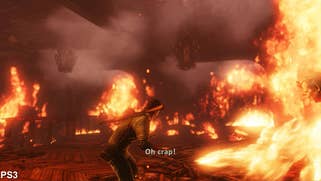




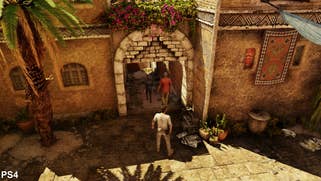
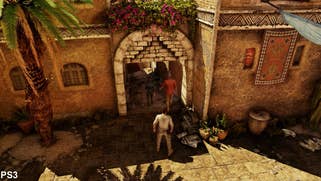
Once we move beyond the list of expected improvements, we begin to see a greater difference between Uncharted 3 and the rest of the collection. Both Drake's Fortune and Among Thieves received a healthy dose of new assets including models, textures, and effects. In comparison, Uncharted 3 benefits much less from such changes. That's not to say we didn't find improvements, but those present are far less expansive overall.
While geometry seems to be a match between the two versions this time around, we did notice plenty of redrawn textures. During normal gameplay, textures actually appear very similar between the two versions with the lower rendering resolution of the PS3 original seemingly obscuring detail. Yet, when the camera pulls in for a close-up, it's possible to see that base textures are actually much higher quality on PS4. The texture work on PS3 was already very good, but at 1080p, the upgrades are certainly beneficial.
Then we move onto shadow quality and it's here that we see some rather curious results. Shadow maps retain a fairly low resolution with visible stair stepping visible along the edges. There's improvement on PlayStation 4: it makes use of additional filtering on shadows to help smooth out these rough edges, but it's not entirely successful. In comparison, the PS3 original presents chunky, unfiltered shadows throughout the game. Here we're seeing that Bluepoint has returned to this effect and made it better, but in common with the other work in this game, it's not quite the night and day difference we see with other elements elsewhere in the collection.
On the other hand, contact shadows receive a noticeable boost in quality on PlayStation 4. The solution utilised on PS3 tends to introduce smoky black halos around objects and characters, leading to some rather awkward-looking situations - quite a few of the ambient occlusion techniques seen in the last-gen were somewhat heavy-handed in this way. The AO implemented on PS4 in the Nathan Drake Collection is of a higher precision and manages to avoid these artefacts while still adding depth to the scene.
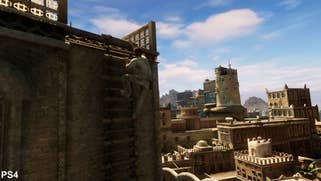




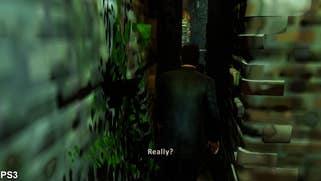


Moving on, one of the standout visual features introduced in Uncharted 3 is volumetric lighting. Used for elements such as flashlight beams or rays of sunlight, the effect is present throughout the game. Unlike a screen-space effect, these light-shafts remain properly visible even when the source is occluded from view. On PS4, the precision of these volumetric light shafts is higher than its PS3 counterpart. In the original game, objects passing along the perimeter of the light volume also tended to exhibit saw-tooth artefacts - and this have been eliminated on PS4.
Conversely, the red glow or 'colour bleeding' of the red channel used to emphasise high intensity lighting has been reduced or even removed on PS4. This is most noticeable around the flames during the chateau escape sequence but can be observed in other scenarios as well. It's unclear if this effect was eliminated for technical or artistic reasons, but its absence is difficult to explain. It only really tends to be noticeable on a direct A to B comparison, but it's an example of how a small handful effects in the original games don't manage to find their way across to the Nathan Drake Collection.
Depth of field also receives a boost in quality. On PS3, during both real-time and pre-rendered cut-scenes, foreground objects placed against an out of focus backdrop tend to exhibit edge artefacts where the two intersect. The remastered version utilises a higher quality effect that eliminates these issues. It's another example of how Uncharted 3's remastering here is more about refinement than it is about fundamentally altering or dramatically improving the game, as opposed to some of what we saw in Bluepoint's work on the two previous games.
Alongside the release of the Nathan Drake Collection, Bluepoint has released a patch designed to improve upon a number of issues. While the game included on the disc is exceptionally solid, the patch definitely adds some extra polish. Two of the most important features made available in patch 1.01 include performance improvements and higher quality shadow rendering.
In terms of frame-rates, we see a definite improvement to an already very stable experience. For example, the initial ruins section in the original game suffered from dropped frames both during exploration and while engaged in a gun battle later. We noted dips to around 55fps during this section that persisted throughout. With the patch, we see only a minor stutter upon initial arrival at the scene but this quickly clears up and the section continues with a very stable 60fps.
With Uncharted 2, instances of slowdown are more common, yet we also see improvements with the 1.01 patch. Gun battles in the swamps of Borneo regularly saw performance dip below 60fps in the original version - this is still in effect even on the patched version, but the average frame-rate is 2-3fps higher on average, producing a smoother experience during these challenging sections. This is consistent with Uncharted 3 as well, where dips have either been improved upon or eliminated completely.
It's important to note that even in the unpatched version, performance issues are relegated to specific scenes while the majority of the game operates without issue. The patch eliminates these blips in some sequences while simply improving the average level of performance in others. Either way, the overall level of performance significantly exceeds The Last of Us Remastered, which could see extended sequences where the game failed to sustain its 60fps performance target.
Shadow quality is also improved in the day one patch. The original release utilised a dithering effect around the edges of certain types of shadows. With 1.01 we see the filtering method changed and dithering removed from all affected areas, resulting in a smoother overall presentation. It's impressive that Bluepoint was able to improved shadow quality while simultaneously increasing performance - shadow rendering is one of the more computationally expensive tasks for the GPU.
Uncharted: the Nathan Drake Collection - the Digital Foundry verdict
In regards to Uncharted 3, Bluepoint's upgrades may seem relatively minimal in comparison to the rest of the Nathan Drake Collection, but there are still plenty of changes here that push its quality beyond that of your typical remaster. The refined image quality, enhanced texture work, and smooth frame-rate are all welcome additions, but it's the more responsive controls that really steal the show here. The game now plays exactly as we had originally wanted.
Now that we've examined the collection as a whole, we can sit back and really appreciate the scale of the achievement here. We've finished all three games on PS4 and can safely say that each of them benefits greatly from the changes. Bluepoint made smart choices here that manage to create a very consistent package from start to finish - a remarkable accomplishment here bearing in mind that the original games span almost an entire console generation. We've always thought highly of Bluepoint's work on remaster projects but, with The Nathan Drake Collection, it has established itself as the premier studio for this type of work. Only the likes of HexaDrive and M2 have the body of work and the attention to detail to compare.
As for the games themselves, anyone that fondly remembers these titles should enjoy the improvements made to them. Both the visual and gameplay improvements elevate the experience beyond the PS3 originals. The gameplay changes made to the first and third game in particular really make a difference here. Yet, according to Naughty Dog, 80 per cent of PS4 owners have never played Uncharted and that's really the target audience here. Suffice to say, if you're among that group, there is no better time to jump in.










